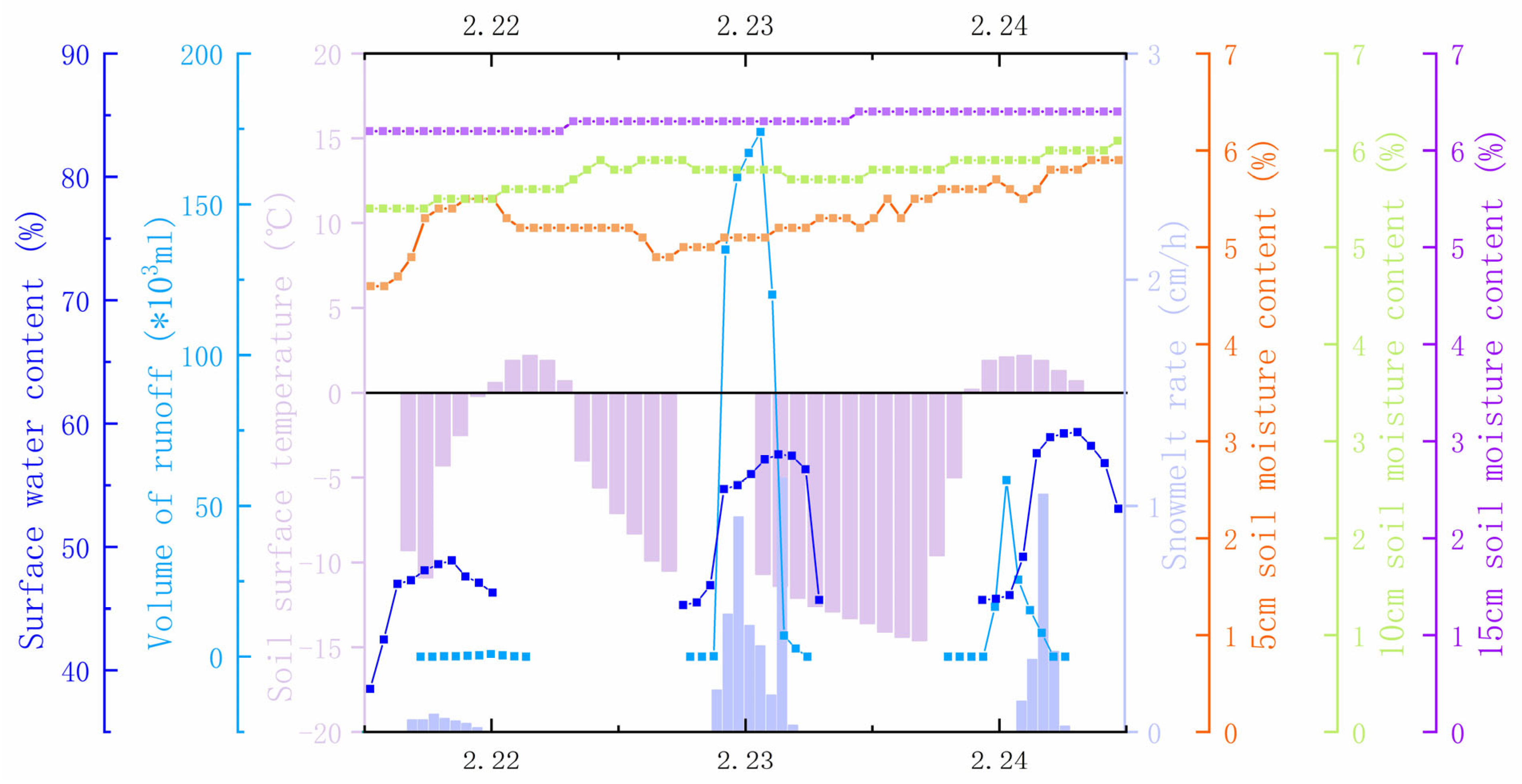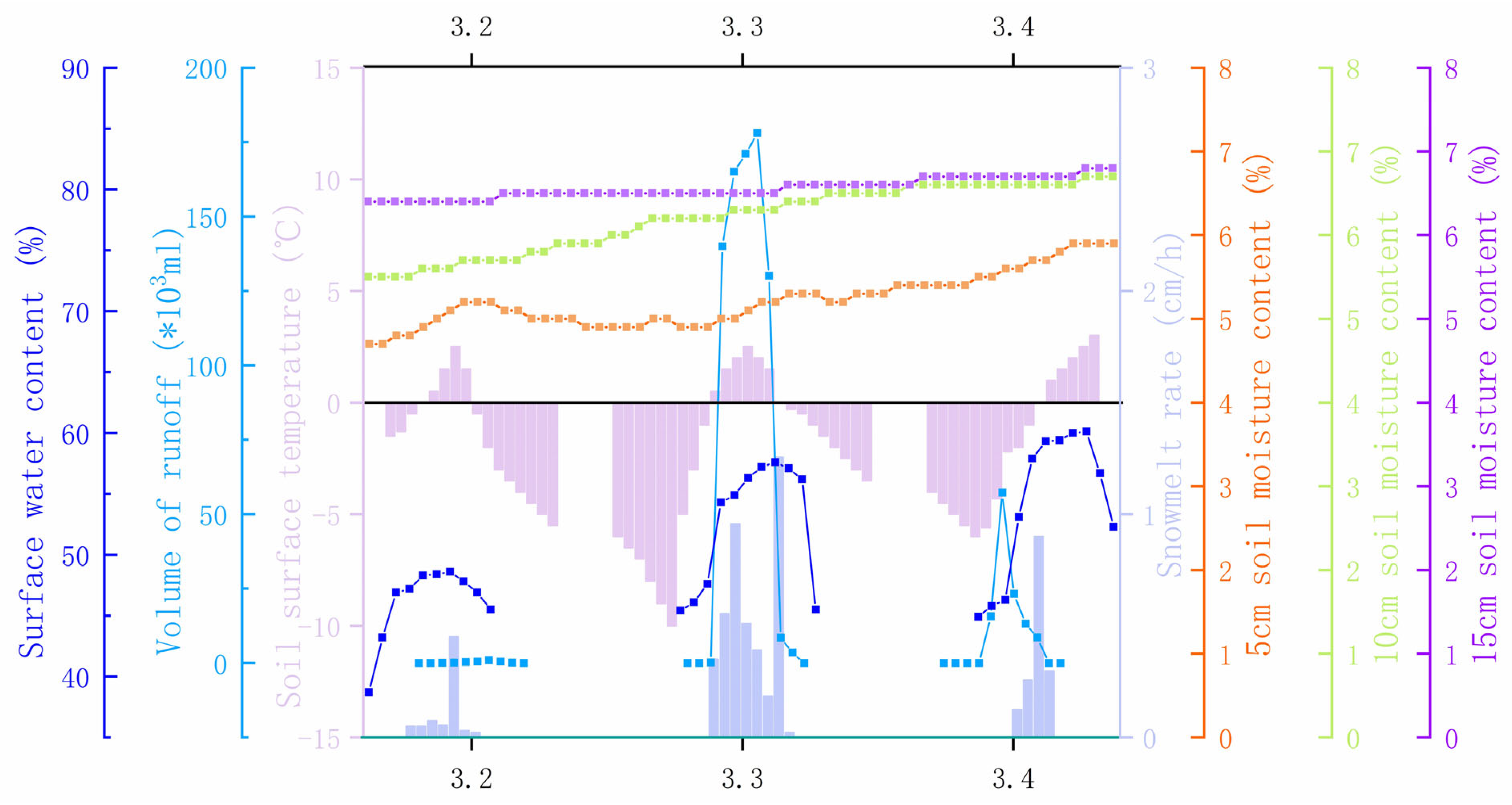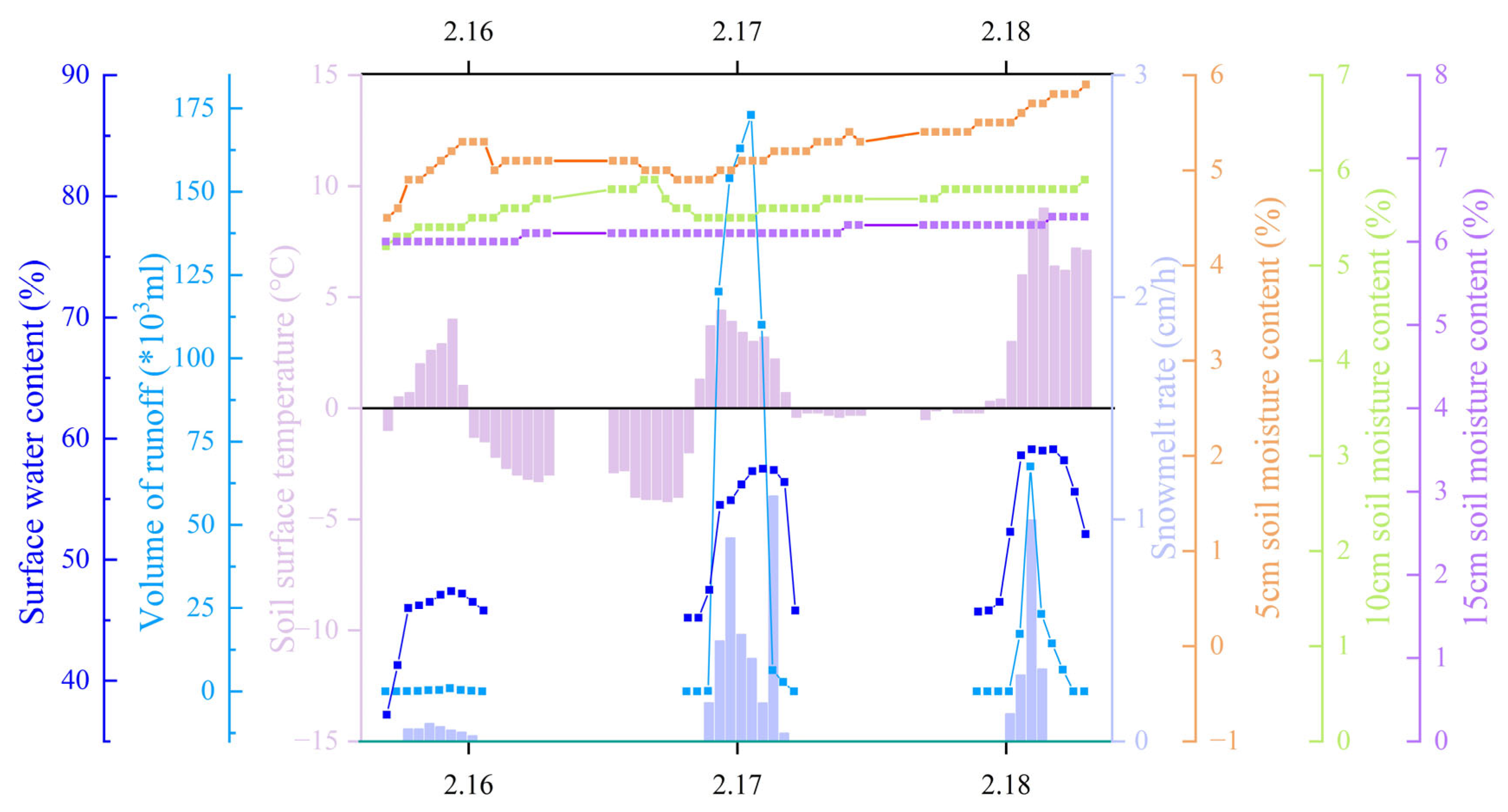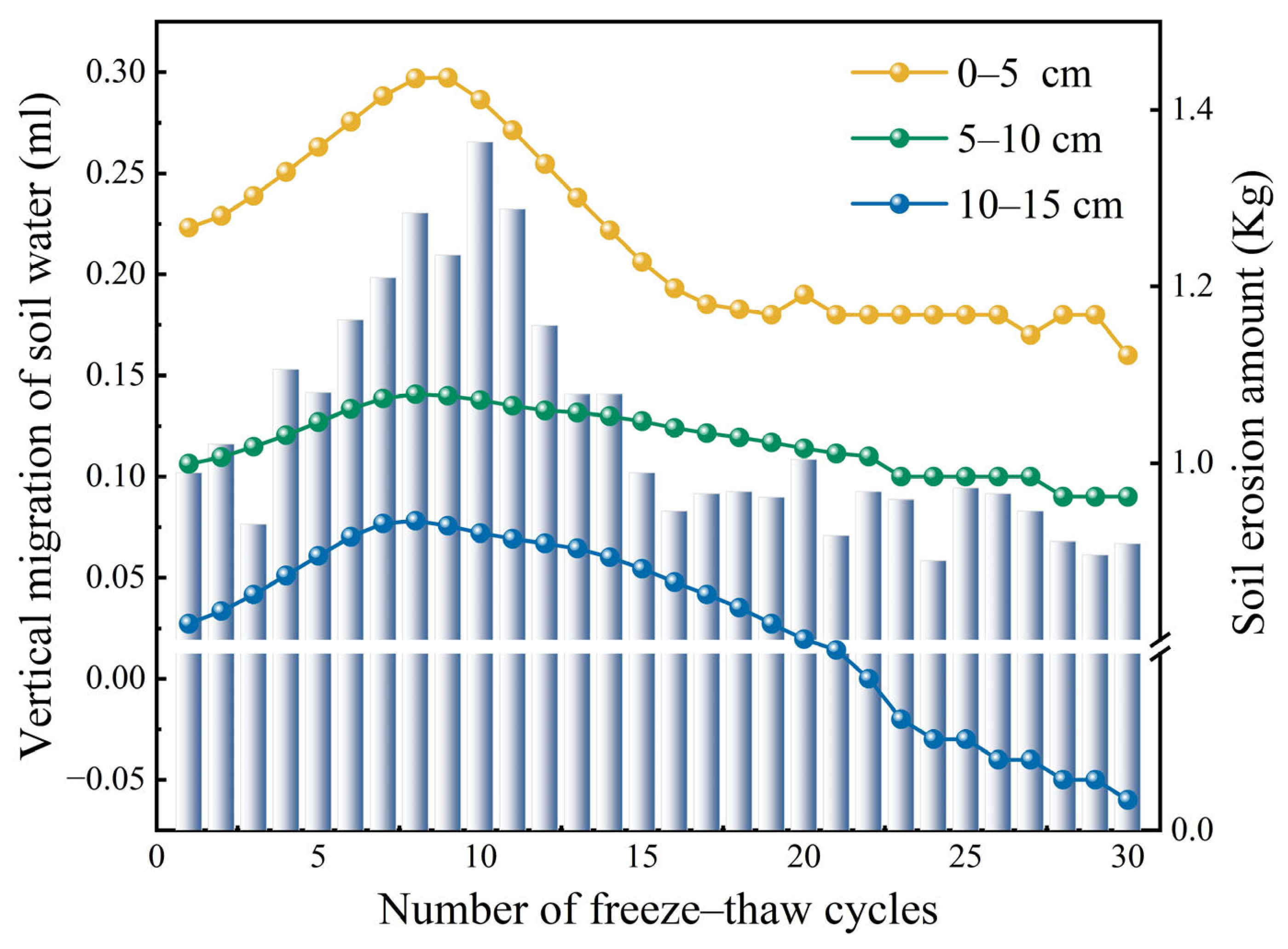Laboratory Experiments Unravel the Mechanisms of Snowmelt Erosion in Northeast China’s Black Soil: The Key Role of Supersaturation-Driven and Layered Moisture Migration
Abstract
1. Introduction
2. Materials and Methods
2.1. Site Description
2.2. Field In-Situ Monitoring
2.3. Laboratory Experimental Design
2.4. Measurement of Indicators
2.5. Data Analysis
3. Results
3.1. Soil Conditions That Produce Snowmelt Runoff
3.2. Development Law of Black Soil Snowmelt Erosion Under Different Soil Conditions
3.3. Effects of Water Transport on Soil Structure Change and Erosion Amount Change
3.4. The Main Soil Factors Affecting Snowmelt Erosion
4. Discussion
5. Conclusions
Supplementary Materials
Author Contributions
Funding
Institutional Review Board Statement
Informed Consent Statement
Data Availability Statement
Acknowledgments
Conflicts of Interest
Abbreviations
| VIP | Variable importance in projection |
| GB/T | Geotechnical Testing Method Standard |
| PLSR | Partial least squares regression |
| SMVM | Soil moisture vertical migration |
| FT | Freeze–thaw |
| Dc | Detachment capacity |
| UW | Unit weight |
| P | Porosity |
| OC | Osmotic coefficient |
| GWC | Gravimetric water content |
Appendix A
Appendix A.1

Appendix A.2

References
- Matiu, M.; Hanzer, F. Bias adjustment and downscaling of snow cover fraction projections from regional climate models using remote sensing for the European Alps. Hydrol. Earth Syst. Sci. 2022, 26, 3037–3060. [Google Scholar] [CrossRef]
- Bai, Q.; Zhou, L.; Fan, H.; Huang, D.; Yang, D.; Liu, H. Effects of Frozen Layer on Composite Erosion of Snowmelt and Rainfall in the Typical Black Soil of Northeast China. Water 2024, 16, 2131. [Google Scholar] [CrossRef]
- Zhang, X.; Ma, Y.Y.; Li, X.Y. Effects of freeze-thaw cycles and zeolite blending on black soil physical properties. Trans. CSAE 2020, 36, 144–151. [Google Scholar]
- Wang, L.; Zuo, X.; Zheng, F.; Wilson, G.V.; Xu, X.; Li, Z. The effects of freeze-thaw cycles at different initial soil water contents on soil erodibility in Chinese Mollisol region. CATENA 2020, 193, 104615. [Google Scholar] [CrossRef]
- Li, Y.; Sun, F.; Chen, Y.; Fang, G.; Li, Z.; Duan, W.; Qin, J.; Zhang, X.; Li, B. Unraveling the complexities of rain-on-snow events in High Mountain Asia. npj Clim. Atmos. Sci. 2025, 8, 118. [Google Scholar] [CrossRef]
- Sadiq, M.F.; Naqvi, M.W.; Cetin, B.; Ceylan, H. Role of temperature gradient and soil thermal properties on frost heave. Transp. Res. Rec. 2025, 2679, 217–226. [Google Scholar] [CrossRef]
- Liu, B.; Fan, H.; Jiang, Y.; Ma, R. Evaluation of soil macro-aggregate characteristics in response to soil macropore characteristics investigated by X-ray computed tomography under freeze-thaw effects. Soil Tillage Res. 2023, 225, 105559. [Google Scholar] [CrossRef]
- Zhou, X.; Zhu, Z.; Rezania, M. Multi-phase-field microporomechanics model for simulating ice-lens growth in frozen soil. Int. J. Numer. Anal. Methods Geomech. 2022, 46, 2307–2336. [Google Scholar]
- Liu, C.; Wu, Y.; Li, S. Formation mechanism of ice banding in freezing colloidal suspensions. Colloids Surf. A Physicochem. Eng. Asp. 2017, 529, 1012–1020. [Google Scholar]
- Geng, R.; Zhang, G.-H.; Hong, D.-L.; Ma, Q.-H.; Jin, Q.; Shi, Y.-Z. Response of soil detachment capacity to landscape positions in hilly and gully regions of the Loess Plateau. CATENA 2021, 196, 104852. [Google Scholar] [CrossRef]
- Kong, F.; Nie, L.; Xu, Y.; Rui, X.; He, Y.; Zhang, T.; Wang, Y.; Du, C.; Bao, C. Effects of freeze-thaw cycles on the erodibility and microstructure of soda-saline loessal soil in Northeastern China. CATENA 2022, 209, 105812. [Google Scholar] [CrossRef]
- Zhang, L.; Ren, F.; Li, H.; Cheng, D.; Sun, B. The influence mechanism of freeze-thaw on soil erosion: A review. Water 2021, 13, 1010. [Google Scholar] [CrossRef]
- Liu, B.; Ma, R.; Fan, H. Evaluation of the impact of freeze-thaw cycles on pore structure characteristics of black soil using X-ray computed tomography. Soil Tillage Res. 2021, 206, 104810. [Google Scholar] [CrossRef]
- Zhang, Y.-G.; Liu, S.-H.; Deng, G.; Fang, B.-X.; Zhang, Y.-Y.; Lu, Y. Effect of freeze-thaw cycles on mechanical behavior of clay-gravel mixtures. J. Mt. Sci. 2022, 19, 3615–3626. [Google Scholar] [CrossRef]
- Fang, H.Y.; Sheng, M.L.; Tang, Z.H.; Cai, Q.G. Assessment of soil redistribution and spatial pattern for a small catchment in the black soil region, Northeastern China: Using fallout 210Pbex. Soil Tillage Res. 2013, 133, 85–92. [Google Scholar] [CrossRef]
- GB/T 50123-2019; Standard for Geotechnical Testing Method. China Planning Press: Beijing, China, 2019.
- Fu, Q.; Hou, R.; Li, T.; Wang, M.; Yan, J. The functions of soil water and heat transfer to the environment and associated response mechanisms under different snow cover conditions. Geoderma 2018, 325, 9–17. [Google Scholar] [CrossRef]
- Abdi, H. Partial least squares regression and projection on latent structure regression (PLS Regression). Wiley Interdiscip. Rev. Comput. Stat. 2010, 2, 97–106. [Google Scholar] [CrossRef]
- Li, Z.; Xu, X.; Xu, C.; Liu, M.; Wang, K.; Yu, B. Annual runoff is highly linked to precipitation extremes in karst catchments of southwest China. J. Hydrometeorol. 2017, 18, 2745–2759. [Google Scholar] [CrossRef]
- Jia, S.; Li, H.; Wang, Y.; Tong, R.; Li, Q. Recursive Variable Selection to Update Near-Infrared Spectroscopy Model for the Determination of Soil Nitrogen and Organic Carbon. Geoderma 2016, 268, 92–99. [Google Scholar] [CrossRef]
- Mammadov, E.; Denk, M.; Riedel, F.; Kaźmierowski, C.; Lewinska, K.; Łukowiak, R.; Grzebisz, W.; Mamedov, A.I.; Glaesser, C. Determination of Mehlich 3 Extractable Elements with Visible and Near Infrared Spectroscopy in a Mountainous Agricultural Land, the Caucasus Mountains. Land 2022, 11, 363. [Google Scholar] [CrossRef]
- Fan, H.; Hou, Y.; Xu, X.; Mi, C.; Shi, H. Composite factors during snowmelt erosion of farmland in black soil region of northeast China: Temperature, snowmelt runoff, thaw depths and contour ridge culture. Water 2023, 15, 2918. [Google Scholar] [CrossRef]
- Wang, G.; Mao, T.; Chang, J.; Song, C.; Huang, K. Processes of runoff generation operating during the spring and autumn seasons in a permafrost catchment on semi-arid plateaus. J. Hydrol. 2017, 550, 307–317. [Google Scholar] [CrossRef]
- Jin, X.; Yang, W.; Gao, X.; Zhao, J.-Q.; Li, Z.; Jiang, J. Modeling the unfrozen water content of frozen soil based on the absorption effects of clay surfaces. Water Resour. Res. 2020, 56, e2020WR027482. [Google Scholar] [CrossRef]
- Lu, J.; Wang, T.-H.; Cheng, W.-C.; Yang, T.; Luo, Y. Permeability anisotropy of loess under influence of dry density and freeze–thaw cycles. Int. J. Geomech. 2019, 19, 04019103. [Google Scholar] [CrossRef]
- He, H.; Dyck, M.F.; Si, B.C.; Zhang, T.; Lv, J.; Wang, J. Soil freezing–thawing characteristics and snowmelt infiltration in Cryalfs of Alberta, Canada. Geoderma 2015, 5, 198–208. [Google Scholar] [CrossRef]
- Benard, P.; Schepers, J.R.; Crosta, M.; Zarebanadkouki, M.; Carminati, A. Physics of viscous bridges in soil biological hotspots. Water Resour. Res. 2021, 57, e2021WR030052. [Google Scholar] [CrossRef]
- Casagrande, A. Liquefaction and cyclic deformation of sands-a critical review. Harv. Soil Mech. Ser. Harv. Univ. Camb. Mass. 1976, 88, 10006781910. [Google Scholar]
- Ambraseys, N.; Sarma, S. Liquefaction of soils induced by earthquakes. Bull. Seismol. Soc. Am. 1969, 59, 651–664. [Google Scholar] [CrossRef]
- Terzaghi, K.; Peck, R.B. Soil Mechanics: Engineering Practice; John Wiley & Sons, Inc.: New York, NY, USA, 1948. [Google Scholar]
- Shi, Y.; Zhang, L.; Ma, W.; Yang, C.; Han, D.; Shang, F. Investigating unfrozen water and its components during freeze–thaw action in loess using a novel NMR technique. Eur. J. Soil Sci. 2022, 73, e13262. [Google Scholar] [CrossRef]
- Gulin, D.A.; Fayzullina, E.V.; Sharipova, E.I.; Sultanmagomedov, S.M.; Nasibullin, T.R. Analysis of the Stress-Strain State of the Pipeline in the Areas of Frost Heaving of the Soil Using the SCAD Software Package. IOP Conf. Ser. Earth Environ. Sci. 2021, 666, 042084. [Google Scholar] [CrossRef]
- Franzluebbers, A.J. Water infiltration and soil structure related to organic matter and its stratification with depth. Soil Tillage Res. 2002, 66, 197–205. [Google Scholar] [CrossRef]
- Li, X.K.; Li, X.; Wu, Y.; Wang, F. Experimental study on service performance of capillary barrier cover with unsaturated drainage layer. Chin. J. Geotech. Eng. 2022, 44, 189–194. [Google Scholar]
- Sun, B.; Ren, F.; Ding, W.; Zhang, G.; Huang, J.; Li, J.; Zhang, L. Effects of freeze-thaw on soil properties and water erosion. Soil Water Res. 2021, 16, 205–216. [Google Scholar] [CrossRef]
- Ghazavi, M.; Roustaie, M. The influence of freeze–thaw cycles on the unconfined compressive strength of fiber-reinforced clay. Cold Reg. Sci. Technol. 2010, 61, 125–131. [Google Scholar] [CrossRef]
- Qiao, J.; Zhu, Y.; Jia, X.; Huang, L.; Shao, M. Development of pedotransfer functions for predicting the bulk density in the critical zone on the Loess Plateau, China. J. Soils Sediments 2019, 19, 366–372. [Google Scholar] [CrossRef]
- To, P.; Agius, D.; Cussen, L. Influence of relative density of the granular base soil on filter performance. Acta Geotech. 2020, 15, 3621–3627. [Google Scholar] [CrossRef]
- Han, Y.; Wang, Q.; Wang, N.; Wang, J.; Zhang, X.; Cheng, S.; Kong, Y. Effect of freeze-thaw cycles on shear strength of saline soil. Cold Reg. Sci. Technol. 2018, 154, 42–53. [Google Scholar] [CrossRef]
- Oztas, T.; Fayetorbay, F. Effect of freezing and thawing processes on soil aggregate stability. CATENA 2003, 52, 1–8. [Google Scholar] [CrossRef]
- Duan, Z.; Li, Z.Y.; Wu, Y.B.; Niu, B.; Shen, R.J. Mechanical and microscopic properties of soil according to the rate of increase in pore water pressure. Soil Tillage Res. 2023, 225, 105530. [Google Scholar] [CrossRef]





| Soil Sample (cm) | Medium Sand ~1.00–0.25 | Fine Sand ~0.25–0.05 | Coarse Silt ~0.05–0.01 | Physical Sand Particles >0.01 | Medium Silt ~0.01–0.005 | Fine Silt ~0.005–0.001 | Clay <0.001 | Physical Clay Particles <0.01 |
|---|---|---|---|---|---|---|---|---|
| Black soil (mL) | 0.5 | 4.2 | 26.7 | 31.4 | 10.3 | 15.5 | 42.8 | 68.6 |
| Soil Depth (cm) | Soil Heave | Water Storage Space | Porosity |
|---|---|---|---|
| 0–5 | 0.95 | 0.84 | 0.47 |
| 5–10 | 0.99 | 0.93 | 0.35 |
| 10–15 | 0.99 | 0.94 | 0.60 |
| Soil Depth (cm) | Initial Water Content | Water Content Range | Connection Between SMVM and Soil Erosion Amount | R2 |
|---|---|---|---|---|
| 0–5 | 0.42 | 0.58–0.72 | A = 0.451 + 2.692 × X1 | 0.82 *** |
| 5–10 | 0.35 | 0.44–0.49 | A = 0.247 + 6.757 × X2 | 0.68 ** |
| 10–15 | 0.35 | 0.29–0.43 | A = 0.983 + 2.117 × X3 | 0.56 *** |
| Items | UWs | UWm | UWg | Ps | Pm | Pg | OCs | OCm | OCg |
|---|---|---|---|---|---|---|---|---|---|
| VIP | 0.844 | 0.876 | 1.056 | 0.766 | 0.897 | 1.088 | 1.327 | 0.644 | 1.286 |
| Soil Depth (cm) | Internal Friction Angle | Cohesion |
|---|---|---|
| 0–5 | 0.67 | 0.718 |
| 5–10 | 0.722 | 0.779 |
| 10–15 | 0.807 | 0.71 |
Disclaimer/Publisher’s Note: The statements, opinions and data contained in all publications are solely those of the individual author(s) and contributor(s) and not of MDPI and/or the editor(s). MDPI and/or the editor(s) disclaim responsibility for any injury to people or property resulting from any ideas, methods, instructions or products referred to in the content. |
© 2025 by the authors. Licensee MDPI, Basel, Switzerland. This article is an open access article distributed under the terms and conditions of the Creative Commons Attribution (CC BY) license (https://creativecommons.org/licenses/by/4.0/).
Share and Cite
Zhao, S.; Fan, H.; Lin, M. Laboratory Experiments Unravel the Mechanisms of Snowmelt Erosion in Northeast China’s Black Soil: The Key Role of Supersaturation-Driven and Layered Moisture Migration. Sustainability 2025, 17, 8737. https://doi.org/10.3390/su17198737
Zhao S, Fan H, Lin M. Laboratory Experiments Unravel the Mechanisms of Snowmelt Erosion in Northeast China’s Black Soil: The Key Role of Supersaturation-Driven and Layered Moisture Migration. Sustainability. 2025; 17(19):8737. https://doi.org/10.3390/su17198737
Chicago/Turabian StyleZhao, Songshi, Haoming Fan, and Maosen Lin. 2025. "Laboratory Experiments Unravel the Mechanisms of Snowmelt Erosion in Northeast China’s Black Soil: The Key Role of Supersaturation-Driven and Layered Moisture Migration" Sustainability 17, no. 19: 8737. https://doi.org/10.3390/su17198737
APA StyleZhao, S., Fan, H., & Lin, M. (2025). Laboratory Experiments Unravel the Mechanisms of Snowmelt Erosion in Northeast China’s Black Soil: The Key Role of Supersaturation-Driven and Layered Moisture Migration. Sustainability, 17(19), 8737. https://doi.org/10.3390/su17198737








